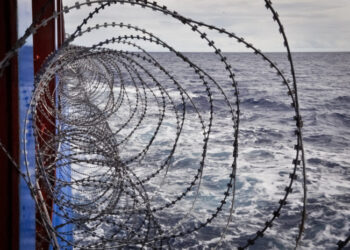Diaplous Group has issued a white paper to inform about the complex environment of maritime security in the Indian Ocean Region (IOR) and to assess whether the High-Risk Area (HRA) is worth it to be maintained or abolished.
The company highlights the importance of identifying the threats and the geopolitical issues of the IOR for better decision making, noting there was an ‘eager intention from some representatives of International Organizations to declassify the HRA due to reasons known to them’. As such, the white paper attempts to assess what a declassification of HRA would mean and the potential consequences and hazards.
The HRA reflects the area where the threat from piracy exists. In 2010 the HRA defined as the area bounded by Suez and the Strait of Hormuz to the North, 10°S and 78°E. From 2010 until now the HRA has been reduced 3 times (2015, 2019,2021). Latest amendment of the HRA became effective from 1st September 2021.
Current threats
With regards to Somalia, Diaplous says that bombing attacks are executed on weekly basis in the capital of Somalia next to Governmental premises. Criminal gangs that used to act in the Somali coast, now prefer to deal with less risky business such as arms trafficking, smuggling, drugs etc.The geopolitical landscape in Somalia remains unstable/fragile, with multiple conflicts going on, and the strong presence of the Al-Shabaab jihadist group. Diaplous estimates that regional rivalries could potentially extend to territorial waters and pose a real threat to vessels transiting the region.
Considering the ongoing regional conflict, the situation in Yemen remains extremely fragile, posing a severe threat to any kind of operation, developing in the region. Repeating strikes launched from Houthi rebels towards Saudis and vice versa have created an insecure environment, posing a direct risk to vessels transiting the Red Sea, Bab el-Mandeb, and the Gulf of Aden.
Diaplous estimates that security threats in Yemen, particularly close to the city of Hodeidah, within the next twelve months, will remain the same. Stability or any other sort of détente in the volatile region is far from being reached, thus both onshore and offshore activities should be carried out with extreme caution, applying all mitigation measures as recommended by the BMP5. Extremist activities are executed at land-based facilities, through its coastal sea but also in nearby countries. Significant investments have also been made especially in the Oil & Gas industry, which due to geopolitical tension are vulnerable to be damaged.
Since the Islamic insurgency of Al-Sunnah, dating back to 2017, Mozambique has found itself confronted with security challenges, in addition to the already exacerbated economic situation and poverty. Following the recent Islamic attack in June 2020, resulting in the seizure of the coastal town of Mocimboa da Praia, a heightened maritime threat for vessels sailing off the coast of Mozambique surfaced. Insurgents, being aware of the deficiencies Mozambiquan security bodies present, have levelled up their offenses by launching amphibious, along with landward blows
HRA Assessment – Where are we heading to?
The white paper states that various representatives support via International Forums the HRA declassification, based on their own risk assessments and based on below arguments:
a) There are no piracy incidents
b) Somali pirates have been eradicated
c) The payment system of the pirates has been exterminated
d) Somalia has become a well-organized State
e) There are serious entrepreneurs in Somalia whose Somali presence creates a lot of issues
f) There is a fit for purpose BMP5
However, the above arguments can be easily refuted as follows:
- Piracy is not executed when the Holistic Maritime Security System (HMSS) is implemented in the HRA
- Pirate groups that used to act around the coast are currently deal with less risky criminal business
- The Organized crime is always ahead the legal order that is why it is being evolved, for instance criminal transactions are executed through crypto coins
- Somalia is far away from being considered a well-organized country
- Serious entrepreneurs are also in other countries such as in Nigeria, Togo, Syria despite the breach of security in those areas
- A BMP5 manual / instructions is not sufficient to prevent and deter a hostile act on itself
- None Risk Assessment on its own can guarantee that a vessel will not be attacked in future
Therefore, questions / concerns should be raised in relation to:
- Why the familiarization with the risk has made us to neglect that risk?
- Who will be benefited from that abolishment? (certainly not the crews)
- Who will take the responsibility?
- Who will be summoned to cover that security vacuum? Are there any other Security Organizations interested to refill the security vacuum to be created?
➢It should be ensured that vessel’s owners, charterers, ship managers etc. should always maintain the free choice to select, deploy armed security
➢ It should be also ensured that the legal framework to deploy armed security is guaranteed at all times.
The white paper concludes with some interesting key points, highlighting that the risk of piracy is deemed to be low, however, admittedly, the risk from other type of threats, like terrorist threat, has significantly increased, thus the use of PAST on merchant vessels while transiting the HRA is strongly recommended more than ever!
It would be a pleasant “treat” the HRA to be considered safe, but the abolishment of the Holistic Maritime Security System (HMSS) would be considered an extremely unpleasant “trick” for the shipping community.
…Diaplous Group concludes in its recently published White Paper entitled ‘Trick or Treat’ : Reduction/ Abolishment of HRA in the Indian Ocean Region.






























































